Resistance to Change and Other Challenges in Construction
What happens when you meet your heroes in Vegas? Carpenter and FHB ambassador Elly Hart recounts her experience at IBS 2020 and interviews three influential industry experts.
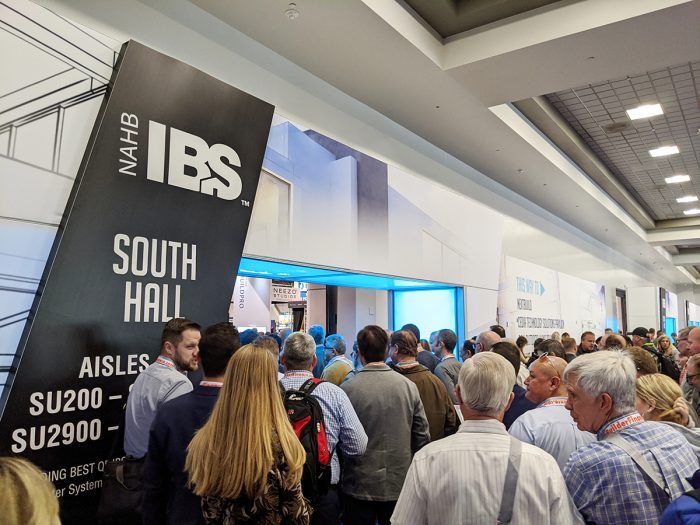
The Road to Vegas
“So are you here for the first time or are you here for a good time?” my Uber driver asks as he pulled away from the curb.
Did he just insinuate my first trip to Vegas would not be good? I hesitantly ask if they are mutually exclusive and think perhaps it’s better to not know the answer. “It depends on what you want to do, but people tend to go a little crazy the first time. They overdo it,” he tells me.
I wasn’t planning on coming to the International Builders’ Show this year. I had wanted to come the year before, but I had to be in school for my fourth and final year of technical training and then I was getting on a plane to help a friend on a custom-home build overseas. I had to do seven weeks of technical training per year in order to meet the requirements of my apprenticeship and I always scheduled them for the winter. I felt better about sitting inside a classroom when it was cold outside.
Natasha Fritz, owner of Natural Carpentry, brought the show to my attention this time. She is participating in a discussion panel and suggested that we go together. We had met in Toronto a few months earlier while I was on vacation and I thought highly of her as a friend and female role model. She’s the only person I know who can talk about work with me for hours and hours and not get bored. Natasha is a rare bird.
Before I knew it, I had bought a plane ticket to Vegas and submitted a request for leave. I felt guilty about taking off on such short notice, especially since the new year had started with what felt like a never-ending game of whack-a-mole. Record rainfall followed by record snowfall led to a week of chasing and fixing leaks in the unfinished building envelope. We had some structural rework to complete at the main entrance, the temporary power panel exploded, a crane put a dent in the newly installed metal siding, and a fire-stop inspection revealed minimum-clearance issues inside one of the adaptable suites. I was burned out and it was only the second week of January. Vegas presented an opportunity to reset. The boss told me to go, have fun, and not think about work.
It was officially happening. Natasha and I were going to fly into the entertainment capital of the world from opposite ends of Canada and spend three days geeking out over new technology in the building industry. I didn’t know it at the time, but my expectations for the trip would be completely off the mark.
Influencers
Natasha and I spend the first morning picking up our name tags and orienting ourselves inside the convention center where we discover over 1400 exhibits spread out over three halls, each one the size of a small city. There are upper floors and lower floors, doors that lead to more doors, and dozens of events going on at any given moment. I stand in line with people who have trekked in from as far away as Austria and China. The show is way, way bigger than I imagined.
At almost 4pm on day one of the show, I make eye contact with someone in the crowd. He’s tall with a familiar grin. Who is he? Why do I feel like I know him?
We are at the outdoor exhibits where we have set up a merchandise table with all proceeds going toward the support of women in the trades. The familiar stranger disappears into the crowd just as my phone buzzes. It’s Tim Uhler, lead carpenter for Pioneer Builders and @AwesomeFramers on Instagram, telling me where to meet up with him. Our attempts to find each other during the day were unsuccessful and this is our last chance to meet before we leave the show to attend separate evening events.
I make my way over to the two-story tiny home display less than 20 ft. away from where we had set up our table, weaving in and out of the crowd that appears to have doubled in the last few minutes. I see Tim before he sees me and I run over to him. He greets me with a big bear hug.
“It’s so good to finally meet you in person,” I said breathlessly. “You’re taller in real life!”
Tim is the big brother I never had and the mentor I never knew I needed. We connected over roof-framing math, ’90s pop music, and jokes about being vertically challenged on the job site. Although we live in the same climate zone and deal with the same seismic-related challenges, Tim’s extensive experience has revolved mostly around single-family homes while my short time in the field has mostly been on multifamily builds. He has a knack for being honest yet kind with his advice.

Standing next to Tim is the tall man with the familiar grin I had spotted in the crowd moments earlier.
“Kyle!” I exclaim. “You’re also taller in real life!”
Two gentlemen standing to my left, who also look vaguely familiar, are politely watching this interaction go down. I turn over one of their name badges and giggle at the words printed on it. “Sherlock Holmes, Plastpro Inc.” But what’s your real name, I wonder. Tim seemingly reads my mind and asks if I have met Mark Martinez and Gary Katz.
I do a double take. Gary Katz wrote a series of articles on his website explaining how he installs prehung doors. Those articles taught me how to check for cross-leg with a stringline and detailed a process that made door installation one of my favorite tasks on the job site. (I would learn at his demonstration the next day that this process is not without controversy.)
During my first year of technical training back in 2015, I was working on a hip-roof framing assignment when one of the instructors came over and explained how he ended up with a bad elbow after years and years of framing with 28-oz. steel hammers, similar to the one provided by the school. He told me to save my elbow and get a Stiletto. I took note of the advice, but I felt it was something I had to earn.
A year later, I had a Stiletto Tibone II in my hands—and this was my introduction to its creator, Mark Martinez. This hammer was a joy to use and had sentimental value to me. I didn’t realize how attached I was to it until I made the mistake of putting it inside the job office where it was promptly stolen in a break-and-enter just before Christmas along with some other tools I had set aside for milling grooves into window sashes. I had chosen convenience over security and paid the price.
“Send me a message and we’ll get you sorted out,” Martinez says as we part ways. I appreciated the gesture, but I felt it was something I had to earn.
Parallel worlds
I wake up to an alarm I would normally snooze three or four times, excited to get a head start on day two. If I want to see everything I want to see and get to all of the events I want to go to, I have to talk less and walk more. Natasha says she has to get ready for her discussion panel and will join me later.
We had found our way to Vegas’ famous boulevard the night before. We marveled at garish neoclassicism juxtaposed with contemporary architecture, we laughed at attempts to get us to pay for winter conditions inside an ice bar (we’re from Canada!), we saw people drinking in public and smoking inside, and we wandered mindlessly through indoor shopping malls with fake skies that led to casinos with no clocks and no windows.
Our night out on the town parallels the experience inside the convention center in some ways. Exhibits spill into one another and carry over to demarcating spaces the same way poker tables and bright lights connect hotels along the boulevard. There’s no beginning and no end. You have to step outside or pay attention to dissipating crowds to sense that time is passing at all.
Our accommodation is less than a block away from the back entrance of the convention center, but it’s still a brisk 15-minute walk from one end to the other. I head straight for the Huber booth located in the Central Hall, which is where I’m supposed to meet Tim. The plan is to get in there early, walk through the show together, and get his thoughts about some of the new technology on the floor.
But that is not to be. A security guard in a suit and tie stops me at the entrance. “Exhibitors only until 9am,” he says unceremoniously. I guess I won’t be getting a head start after all.
The hierarchy tree
Architects are like the brass ring of the home-building industry. A ubiquitous yet elusive agency at the top of the tree, everywhere but nowhere, seemingly always out of reach for those of us with boots on the ground. Messages from the bottom up are prone to getting lost among the branches, while messages from the top down seem to get dropped on us when we least expect it. Steven Baczek says that’s deliberate. He knows because he’s one of the architects at the top of that tree.
“Architects are a funny breed,” he says as we sit down for lunch. “They tend to want to complicate things, so the solution seems more intriguing with the perceived value of extensive thought.
“For some, they’re like the Wizard of Oz. They live behind a curtain and they don’t want you to see what’s behind it … they want you to think they’re this all-powerful person on the screen.”
Baczek’s refreshing candor combined with his work as an educator is challenging the status quo and encouraging meaningful dialogue between all the different branches of the tree. He’s one of few architects on social media who prefers technical discussions over pretty photos of finished houses, which aligns more closely with my own experience working on multifamily builds where efforts concentrate on the unglamorous and undervalued side of their profession. Find him here on Instagram.
Pretty photos of finished houses are fun to look at, but they often don’t tell the truth about what battles were fought by the architect to get that result. They don’t show you the unpopular decisions that were made to fulfill their professional obligation to life safety, or the horizontal angle of daylight considerations that dictated the placement of those windows, or the floor-space-ratio calculations that contributed to the shape of the building. There’s so much more to the design and execution of a build than what we see from the outside, and Baczek says those assumptions lead to expectations that impact everyone on the tree.
“Business is based on expectations. Clients come to me and they have expectations about how much they want to pay for the job. As an architect, there are expectations that I have about the client. I have expectations about what I think my value is, and the builder has expectations about what their value is.
“But because this thing called life gets involved, all of us are challenged to meet the expectations of the other … we need to be able to see it coming and resolve it quickly and not let a little campfire turn into a forest fire. Projects will never be without problems. It’s how we resolve the problems.”
The challenges Baczek deals with as an architect are different to the challenges he faces as an educator. When I asked him about the construction industry’s resistance to change, he said that was a reflection of the process between the highest branches.
“We don’t need to learn how to build, we need to learn how to make decisions. Change equals higher risk and people don’t like higher risk because they don’t understand how to make appropriate decisions.
“When we think about aesthetics as an industry, our spectrum of thought is unbounding. But when it comes to putting the building together, our breadth of analysis gets minimized, mostly because we lack the ability to make appropriate decisions. So we rely on conformity—we do what we’ve always done.”
Baczek is not like most building-design professionals I’ve worked with on the job site, but that doesn’t negate the fact that he’s still an architect. That everywhere but nowhere feeling is hard to ignore in his presence, which perhaps says more about me than him. His demeanor creates a sense of distance that betrays his affable personality. When I admit this to him, he says that’s deliberate too.
“You want people to know that you’re just as comfortable shaking their hand as you are punching them square in the face.”
“And do you live by that?” I ask with a laugh. “It works for you?”
“Yes. I’ve never had to use it, but it’s the attitude.”
Building Science Fight Club
Christine Williamson, the brilliant mind behind @buildingsciencefightclub on Instagram, is sitting next to me at the Plastpro booth, watching Gary Katz and Scott Wells demonstrate how to install a pair of exterior doors. Her admirable work as a consultant and educator is changing the way we think about building enclosures. We met in person for the first time moments earlier and I had to stop myself from behaving like a teenager swooning over a pop star. I was itching to ask her a million questions about a million things. I finally settled on a loaded two-part question.
“What do you think is the biggest challenge when it comes to our buildings? What do we get wrong over and over again?”
“They think in terms of spec section and not in terms of function,” Williamson says. “They think about it by individual trade as opposed to holistically. How can contractors communicate the value of their recommended approach to homeowners in a way that they can understand? And how can homeowners better evaluate what their contractor is telling them?”
Williamson says there is an information disconnect, not only between contractors and homeowners but also between trades. She refers to this as “asymmetrical information,” when one party to an economic transaction knows a lot more than the other. Education is one part of the solution, but she’s unsure what else we can do to address the issue.
“Our building industry is so specialized and that’s a really good thing, but it means the people who are really good at what they do have an added responsibility to not just understand what they do but also how adjacent trades are affected by what they do. The best contractors have an awareness of how their specialty fits in with the whole of the building,” she says.
As we watch Gary Katz hold up a level to the door jamb, I think about Williamson’s comments and how it fits into my own experience working with different trades on-site. What would a holistic approach look like from start to finish? How do we integrate that into the culture and not have it turn into a battle with each trade that comes through the job site?
Williamson whispers that she has to run and slips away. Moments later, Tim arrives and sits down in her now empty seat.
The Katz Roadshow
Gary Katz wraps up his door installation clinic at the Plastpro booth and I watch as members of the audience approach him. He’s a man of many talents, but he’s perhaps best known for channeling his career as a finish carpenter into noble teaching opportunities. He’s the founder of THISisCarpentry.com, an online resource for builders where I found those articles about installing prehung doors, and his work with the Katz Roadshow is filling the need for hands-on training programs in an industry where formal apprenticeships seem to have all but disappeared.
I’m eager to get into my scheduled interview with him so that Tim and I can start walking through the show. There are lots of things we want to see and it is already well past noon. Katz acknowledges me with a wave as his audience disperses into neighboring exhibits.
I start the conversation with a story about my own experience installing prehung doors.
“I learned from reading your articles, as well as from a mentor of mine who happens to be an exceptional finish carpenter, to never put the shims behind the hinges. This method works for me but I shared some images of that process in an Instagram story one time and I had a lot of people telling me I should be putting the shims behind the hinges.”
“Ohhh yeah,” Katz said. “I published my first article in Fine Homebuilding about installing prehungs with no shims behind the hinges and I caught hell for that for years. But I knew it worked because at the time we were doing apartment building after apartment building and I had installed maybe 5000 of them and never had a callback. So anytime someone says that to you, just understand that they haven’t reached that point of realization yet.”
“It was actually kind of funny,” I say. “Because other people were saying it’s good to see you know not to shim behind the hinges.”
“Yeah, I’ve been preaching this for years and it’s slowly becoming accepted. Anytime some knucklehead makes some critical comment, it doesn’t do any good to argue with them. It’s good for you to get that kind of pushback and stand your ground.”
The advice Katz offers is timely. My lack of familiarity with specialized trades makes it hard for me to be assertive on the job site sometimes, even when authority is automatically assumed with the responsibility. I don’t always know who is meant to be doing what, especially when each trade is telling me something different.
“There’s so much new technology at a show like this and it brings up questions for me,” I say. “How do we introduce change on the job site in a way that will have people embracing it?”
Katz points to something on the floor and asks for someone to bring it over to him. It’s a mockup of the door sill from his installation demo.
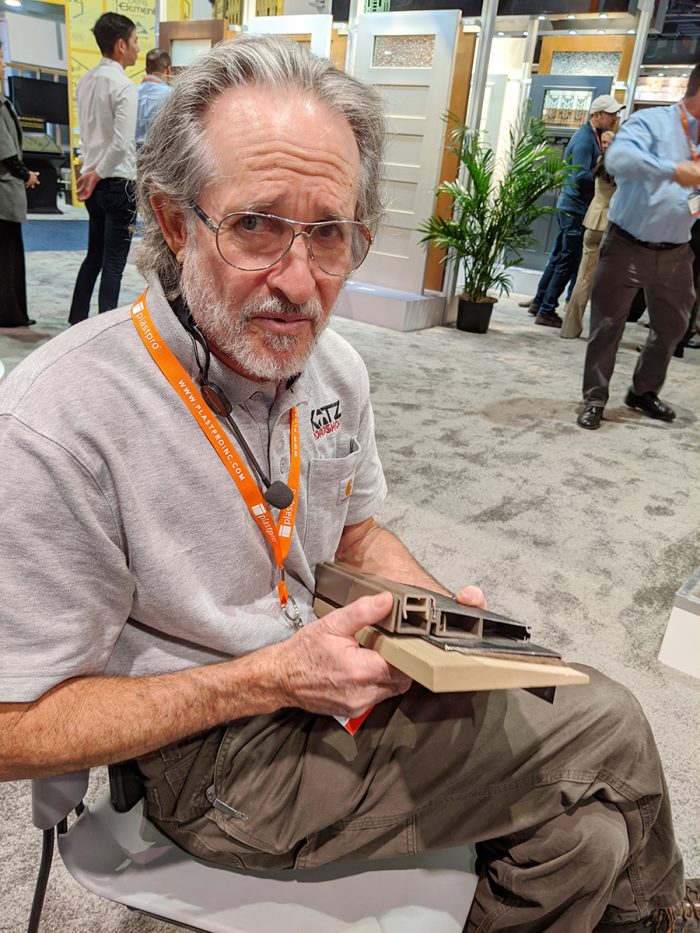
“But you don’t always have that luxury,” I contend.
“You need to prepare yourself ahead of time. You are going to find resistance in our industry everywhere you go. Human beings are naturally resistant to change, and human beings in the construction industry … times 10. I don’t know why. I think it’s because it’s such a bitch of an industry. It’s so hard to learn.”
The mockup is one instrument towards the larger goal of education, which Katz says is the key to overcoming resistance to change as well as the skilled-trades shortage looming over the industry. He says Instagram has revolutionized our sense of community and provided new ways to learn, but it’s not enough.
“I believe that manufacturers have been irresponsible. They have often claimed that they want to support education in our industry, but their primary goal is marketing, as it should be. When I was raised in this business, anybody who worked with their hands was considered to be a laborer, a step up from a garbage collector. Today, I see so many carpenters who have true pride and confidence in who they are and they actually get respect for it.
“But manufacturers and builders need to do more than support Instagram. We need to create an educational system that’s not based on some state requirement for a certain number of hours that you can fulfill by watching some video.”
Katz points at Tim, who is sitting beside us.“We need someone like him in front of people. I can’t think of any other way to achieve it. The lack of education is the biggest problem our industry faces.”
The “new” dilemma
Tim and I begin walking through the exhibits in the Central Hall. We are free of obligations until 3:30pm, which is when Natasha’s discussion panel and Huber’s Best of Social Awards will take place. They are in two different locations and I inadvertently agreed to attend both.
We start with ZIP System™ at the Huber booth, which seems to have the most potential as a disruptor in the industry. Everyone at the show is talking about it. The proprietary system combines a continuous air and water-resistant barrier with an engineered wood panel that eliminates the need for housewrap and a vapor barrier. I’ve yet to see it on a job site in Canada, though.
Next, we stop by the Boral exhibit to get our hands on their TruExterior trim, which is also making waves as a viable alternative to Hardie and PVC. It’s a preprimed composite material made with fly ash, so it can be cut and shaped like wood but doesn’t swell or shrink with moisture or temperature changes. These properties apparently make it suitable for direct contact with concrete or the ground. I can picture my boss raising his eyebrows at this. He’s very particular when it comes to exterior finishing details and his tolerance for risk is low in that department. It would take some convincing from someone other than me.
As we walk through the floor, it becomes apparent that a lot of the technology on display is not new. It’s just new to me. Products like the Prest-on drywall clips have been around for years, providing builders with cost-effective alternatives to wood backing that maximize insulation values. But it challenges deeply ingrained framing methods and introduces a learning curve that affects drywallers.
It seems the target audience at this show is the decision makers—architects, business owners, developers, and project managers. The integration of new technology has to start at the top and work its way down and that unspoken hierarchy prevents those of us at the bottom from questioning a familiar process. Thinking outside the box means stepping out of line. Time-proven methods make us feel safe.
It’s almost 3:30pm. I tell Tim that I’ll meet him at the Best of Social Awards in a little bit, and I head upstairs to join the audience at Natasha’s discussion panel. Once again, security stops me at the door.
“Sorry, ma’am, you don’t have the right pass.”
Finding direction
We had a really late night, but my body clock wakes me up at 6am anyway. Natasha and I attended the Keep Craft Alive fundraising event and the IBS Young Pro Party the night before.
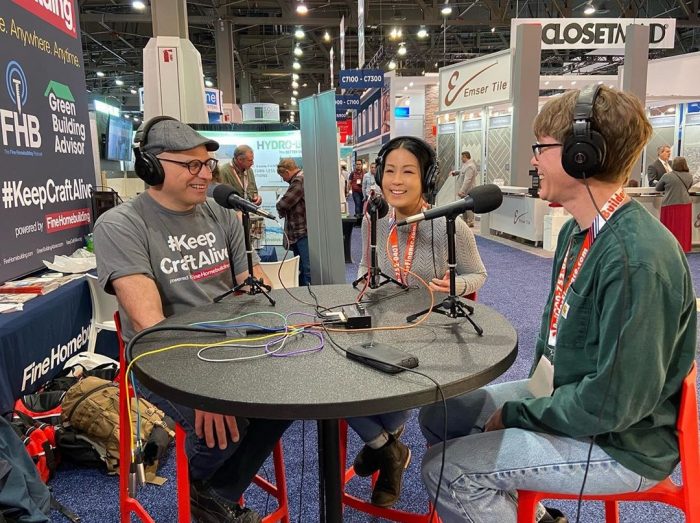
Third-generation carpenter Paul Sprague meets me after the podcast recording and offers inspiration with a delineating viewpoint. Affectionately known online as toolpig, he’s a softly spoken man and highly regarded in the community for his brand-agnostic tool reviews and noble work in the remodeling business. A couple of years ago, I witnessed his influence firsthand when he shared a time-lapse video of our crew working on a 14-in-12 roof. There’s just something provocative about roof-framing imagery that seems to get people all fired up.
Sprague was once knocked off a roof by other workers who fell into him on a framing job where nobody was tied off. The accident resulted in lifelong injuries and questions about the construction industry’s lackluster attitude toward safety. He says fall protection wasn’t even a thing back then and it seems we still have a long way to go.
“This is a different world compared to 20 years ago,” Sprague said. “We have so much more knowledge available to us, but I still get people laughing at me if I have a hard hat on.”
Experience tends to be the most formidable teacher, and Sprague knows that better than most after 30 years in the remodeling business. He says this is why young people, those who represent the future of the industry, are most at risk.
“The biggest challenge is having people own safety in their own minds instead of rejecting it. How do you teach people to have that deep respect for life?”
It’s a good question and it reminds me that I’m as guilty as anyone for using the immediate demands of the job as an excuse to not put on all of my PPE despite being fully conscious of the fact that we work in an industry where the potential for catastrophic consequences is as high as it gets. It seems the low tolerance for risk on the job site doesn’t always apply to our own bodies.
Sprague says everyone has to own the responsibility, and he takes it seriously. He has no hesitation sending people home for disregarding protocols that are in place to keep his workers safe.
“If you don’t respect your life, you don’t respect your job, you don’t respect your trade.”
Meeting places
I meet up with Tim once again at the Huber booth, which has turned into a meeting place of sorts for so many of us at the show. But the sentiment is different this time. Anticipation and excitement have succumbed to a bittersweet realization that the show was almost over.
We start looking for the Smartflower booth, which carpenter and tool expert Kiefer Limeback said I should check out. He probably sees more cool new technology than anyone as part of his work creating content for the building industry. Check out his Instagram here. If he says it’s worth checking out, it’s worth checking out.
We find the small booth tucked away at the far end of the hall and look up to see an enormous piece of European engineering that looks like it came from the future. Smartflower is a ground-mounted 2.5kw solar system with 12 panels that mimic petals. It opens up in the morning, tracks the sun throughout the day, and then cleans itself when it curls up at night. The rep says it weighs about 1500lbs (680 kg) and is 40% more efficient than a regular roof-mounted array.
Despite its sheer size, there is a mesmerizing elegance in the way it moves. It really does remind me of a flower. We watch as the petals close up before making our way over to the North Hall to find builder and educator Mike Guertin.
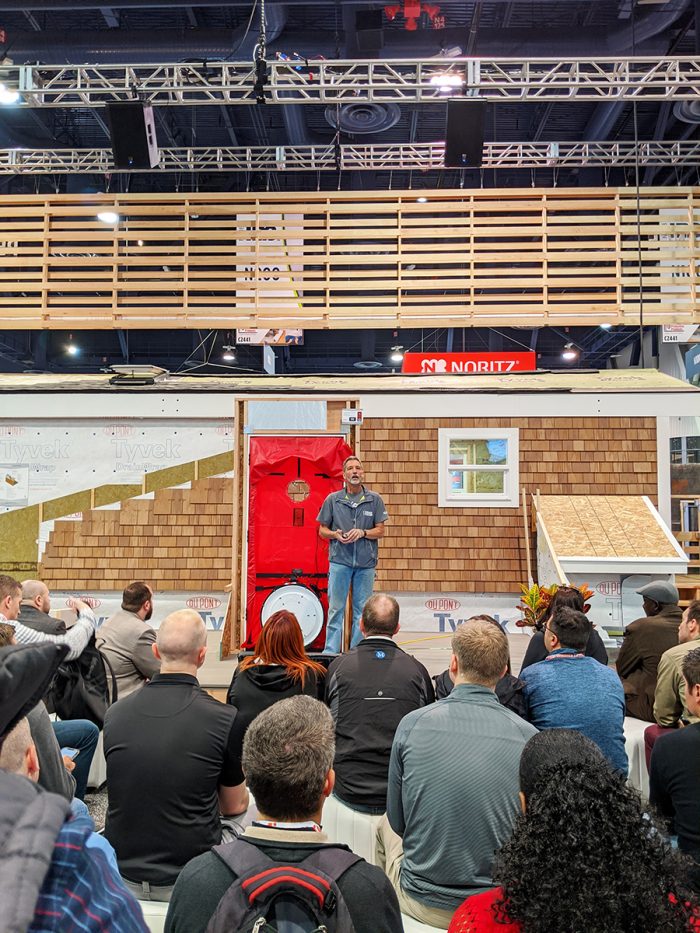
We find him in the High Performance Building Zone at the far end of the hall. I don’t remember what we talked about exactly, but I remember the way he lowered his stance so that we could speak to each other at eye level. I remember thinking he was as humble in his wisdom and authentic in his curiosity as his likeable online personality. And in that moment I realized he was one of many people at the show who seemed familiar–despite never having met before–because of their ongoing influence in my own journey into the trades. I was grateful for the suggestions that I should try to find him. An unlikely chance occurrence had brought me to the show and the opportunity to meet may never present itself again.
For the first time in three days, I get a sense that time is passing. The vibe has changed. The harmonious hum of the crowds has been replaced with the jarring sounds of exhibitors packing up boxes and tables. It’s time to go home.
Burning Questions
A stunning sunset paints the sky as day turns to dusk on the last day of the show, but the colors seem subdued next to the neon lights in this city. My Uber driver was right. I overdid my first trip to Vegas and my senses are overloaded. I’m ready to go home, crawl into bed, and sleep for the next three days.
As Tim and I head outside to the shuttle buses, all of the emotions I experienced throughout the show catch up to me. I fight back tears as we say goodbye and he gives me a big bear hug, just like he did when we first met. Even though I only managed to get a third of the way through my to-do list, I feel like I’ve done it all. Tim and Natasha are a big part of that. They’ve been generous with their time, walked me through the exhibits, gotten us back on track when I got us lost, and introduced me to many wonderful people along the way.
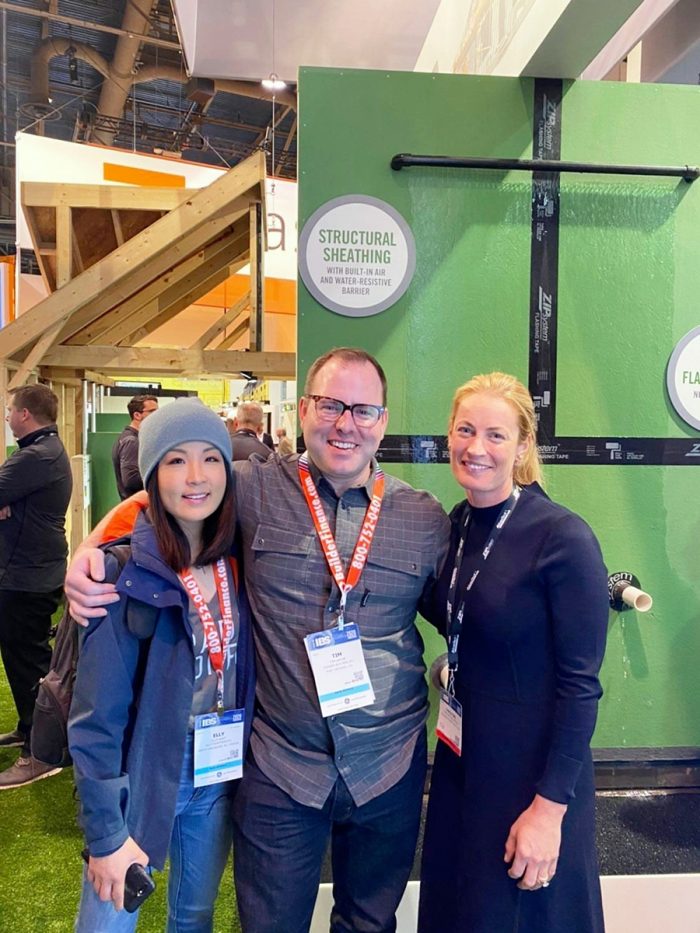
I realized my frustration over day-to-day battles on the job site largely stemmed from my own shortsightedness and a desire for more control over my own experience. I was so focused on my little piece of the puzzle that I couldn’t see the bigger picture. I had to look beyond the cogs in the machine to appreciate the scale and complexity of the system, to see that meaningful change must be integrated gradually rather than implemented ruthlessly. Only then was I able to see irrefutable evidence of progress trickling down.
I left Vegas with newfound gratitude for the trade I had chosen to pursue in an industry that deserves more respect. I got the education I was looking for (and so much more) from people who unwittingly encouraged me to look within to find the answers to my burning questions. The show was a landing place, where whispered hopes and dreams were met with unreserved support, where we celebrated individual success and commiserated over collective struggles, where we introduced ourselves to strangers who seemed more like old friends.
Nothing had gone according to plan, but I couldn’t have asked for a better experience. The show underpromised and overdelivered.
Fine Homebuilding Recommended Products
Fine Homebuilding receives a commission for items purchased through links on this site, including Amazon Associates and other affiliate advertising programs.

Affordable IR Camera

Reliable Crimp Connectors

Handy Heat Gun


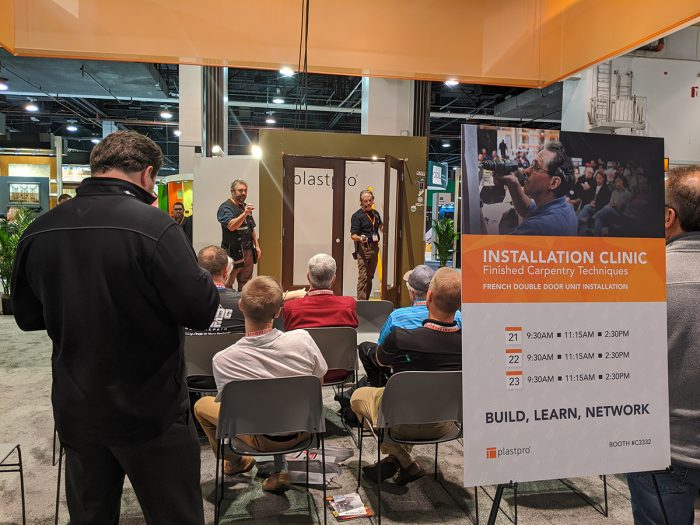

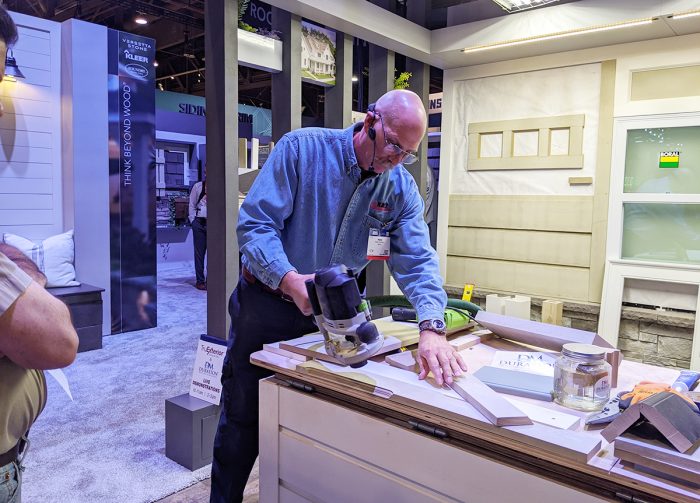
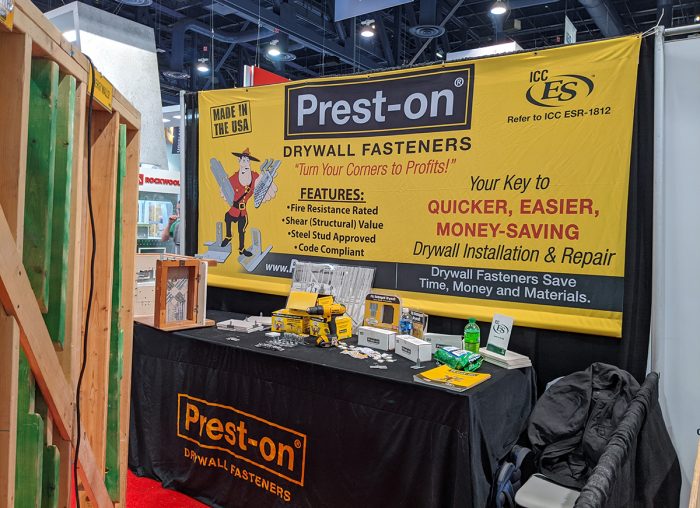

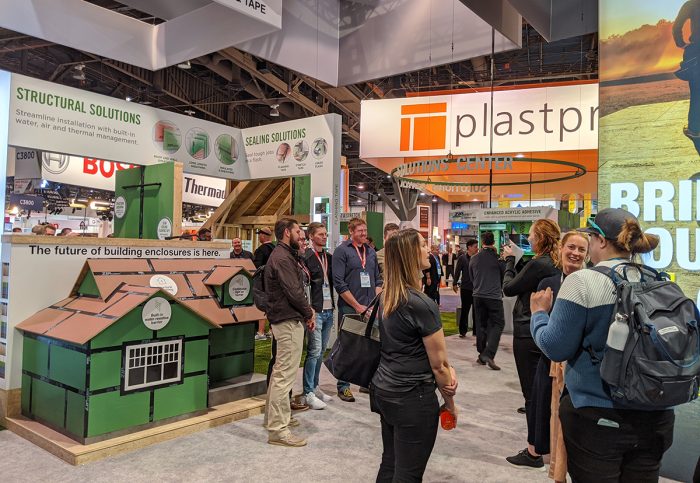

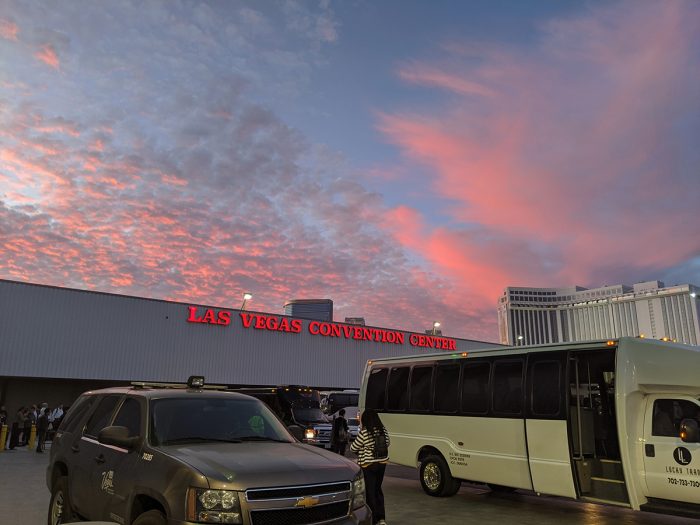
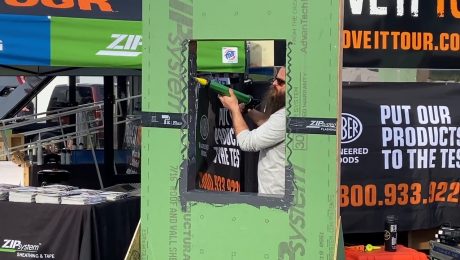
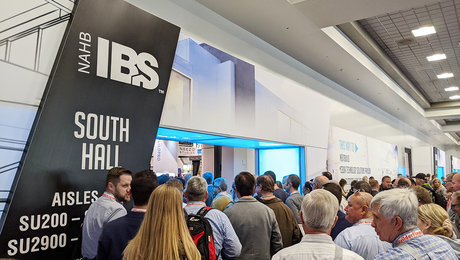
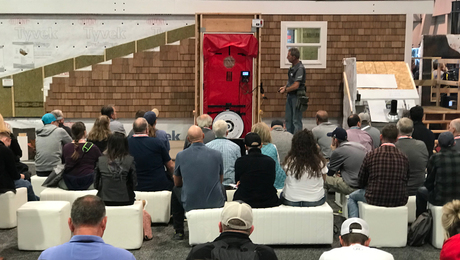
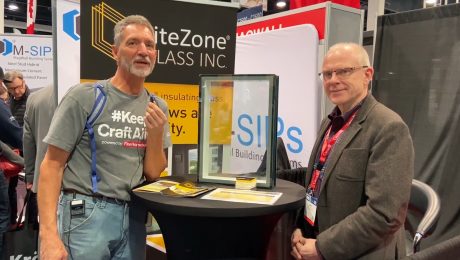























View Comments
Elly - great read!!! It was a pleasure meeting you, and discussing our industry. I didn't really have a plan of attack at IBS, I just rolled with it - But to no disappointment I got to meet many interesting people doing some very positive things for the industry. I'm already looking forward to next year........Long Live Our Buildings....